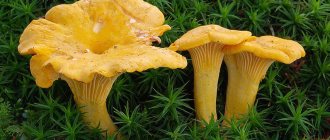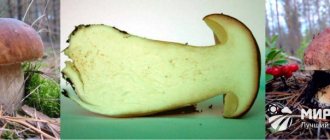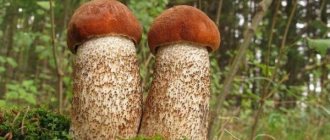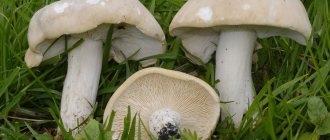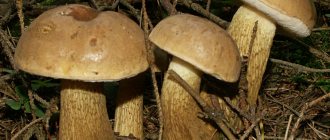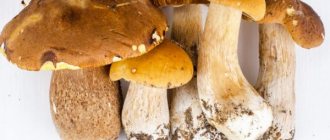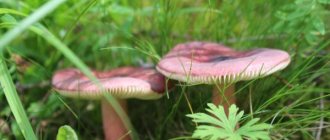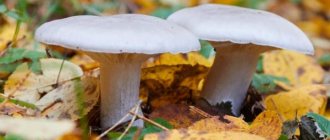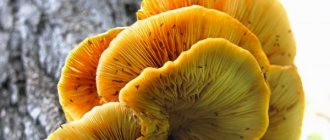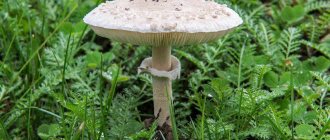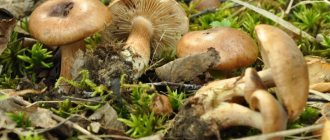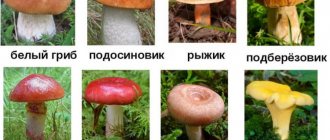Russula mushrooms
The name of the genus of Russula mushrooms is translated from Latin as “reddish”; the genus includes more than sixty species of various colors - from red, brown, green to yellow and white. Mushrooms are elegant and undemanding - they grow on various soils in dry and damp cold weather. They have brittle white flesh and light-colored plates. Contrary to the sonorous name, the fruiting bodies are not eaten raw, and many of them have a bitter taste.
Young russulas are collected together with their stems and carefully placed in baskets on a layer of leaves or moss - fragile mushrooms are difficult to bring home intact. They are suitable for preparing various main courses and homemade pickles.
Types of Russula
Green russula
Green russula
This beautiful, strong mushroom is found in oak and birch forests, where it grows alone or forms small mushroom clearings. The cap is wide, first round, then spread out, up to 18 cm in diameter. The skin is greenish, pale, brownish-green in the center, easily removed.
The leg is dense, 8–10 cm high, light cream, smooth, without thickening at the base and without a ring on the leg. The pulp is white, brittle, with creamy thin plates attached to the stem, neutral taste, without bitterness.
Russula wavy
Russula wavy
A common species that grows in deciduous and coniferous forests, it is noticeable from afar thanks to the bright red tones of the glossy cap - red-burgundy in the center and slightly lighter at the edges. Depending on the place of growth, shades can vary - from lilac-red to crimson and pink.
The cap is hemispherical, up to 6–10 cm in diameter, in old mushrooms it is spread out, while the edges remain curved and slightly wavy. The plates are thin, frequent, milky white. The pulp is strong, slightly pink at the break from the cap, neutral in taste or slightly bitter. The leg has a regular cylindrical shape, creamy white color, and in dry weather it takes on a pink tint.
Russula food
Russula food
In pine forests on sandy soil you can find these tasty mushrooms with a rounded hemispherical cap, which later becomes slightly convex or flat, and then completely concave in the middle. The skin is light red, may have shades of purple, beige or pink, slightly puffy at the edges and is easily removed. The plates are numerous, milky white, then cream.
The leg is dense, thick, white, up to 7 cm high, brownish at the base, and in dry weather takes on the color of a cap. The pulp is pleasant to the taste, without bitterness, with a mild aroma of pine nuts.
How to properly clean and process russula mushrooms?
Let's look at how to clean mushrooms and whether it's worth doing it at all:
- Russulas need to be cleaned depending on their condition. They are very fragile and can easily fall apart. Mushrooms growing on moss do not need to be cleaned; it is only important to inspect them for the presence of worms and rinse them thoroughly.
- Mushrooms growing in sandy areas need to have their stems cleaned. After all, sand and earth could stick to it. But there is no need to remove the film, as the fragile mushroom may fall apart.
Russulas need to be cleaned
- Before preparing mushrooms for cleaning, they should be thoroughly washed or even briefly soaked in boiling water. This will make them noticeably denser.
- Now you can rinse and clean them. It is important to remove all debris: twigs, leaves and adhering soil.
- Mushrooms affected by worms should be thrown away.
- The red and bright blue caps are completely peeled off. Without cleaning, such russula can be bitter.
- Tubular mushrooms need to clean the tubular part of the cap from dirt and debris.
Places of distribution and time of collection
The most delicious species, the russula, lives in deciduous or mixed lowland forests under beech, oak and birch trees. The collection time extends from the beginning of June until the end of August. The common type is valued above others for its pleasant taste, nutty aroma and dense pulp.
Russula wavy is collected from late summer to mid-October and is found in mixed and deciduous forests, on plains and in mountainous areas. The species forms fairly strong, dense fruiting bodies, and therefore is loved by mushroom pickers no less than the previous one.
Green russula often grows under birch trees, forming mycorrhizae with these trees, as well as in light oak forests. The harvest season is in late summer and September. And even in warm October you can come across entire clearings of greenish mushrooms.
The fragile caps, not having time to emerge from the ground, quickly open, attracting hordes of insects to the appetizing pulp. Old specimens are especially fragile and, when collecting them, you can bring home a basket of mushroom crumbs.
Experienced mushroom pickers take only the tight fruiting bodies of young mushrooms, carefully placing them in a basket. They are cut off together with the leg, which is suitable for food, and at the same time checked for worms.
Biological description
In total, more than 270 species of russula have been studied and described; about 70 are found in our forests. All specimens have the same structure, differing only in the height of the stem, diameter and color of the cap.
So, the russula looks like this:
- The cap of young mushrooms is spherical or bell-shaped, straightens as it grows, becoming flat sometimes with a depression in the center, rare, but convex in adult specimens. The white or yellow plates, sometimes fused with the stem, break easily;
- the skin on the surface can be matte and shiny, dry and slimy, sometimes with cracks, with a straight or torn edge. Most often, it can be easily removed, except for the type of loading pads;
- the cylinder-shaped leg
- The flesh of edible mushrooms does not darken when cut, is dense, fleshy, and has a pleasant aroma and taste. Inedible fruits change color when cut, are bitter or have a pungent taste, are odorless or have an unpleasant odor.
Did you know? Some mushrooms have phosphorescent properties, that is, they glow in the dark. This seemingly absolutely useless quality is successfully used by landscape designers.
False russula
The eye-catching colored russulas are not considered the best mushrooms, but are still collected en masse due to their availability and lucky ability to grow everywhere. Their disadvantages are not only fragility, blandness of taste, and the presence of some bitterness, but due to their external diversity they have very dangerous doubles.
Death cap
Death cap
One of the most dangerous mushrooms, the deadly poisonous toadstool, looks like green russula. A greenish glossy cap, up to 15 cm in diameter, frequent white plastics and a neutral taste - these are the main similarities of these species.
The characteristic differences of the pale grebe are a wide and then fringed ring on the leg and a thickened cup-shaped base, a kind of “bag” near the ground. Often in old toadstools the ring disappears and therefore you need to remain vigilant, and if in any doubt, beware and not take a suspicious mushroom at all.
Russula is caustic (burning)
Russula is caustic (burning)
The convex caps of light red or pinkish color are easily confused with the also colored russula and wavy russula. The fragile pulp is white, turning pink closer to the skin, with a light fruity aroma and a pungent, unpleasant taste.
This species is not as dangerous as the previous one, and some mushroom pickers even use delicious-looking mushrooms for food, after boiling them for at least half an hour. At the same time, scientists discovered in the tissues the toxic substance muscarine, which is part of the fly agaric and causes severe poisoning. For this reason, this species cannot be considered edible.
Russula acute (yellowing)
Russula acute (yellowing)
An attractive mushroom with a dense, smooth cap of cherry or red-brown color and a purple tint, similar to wavy russula. The pulp is firm, yellowish, with a fruity aroma, becoming yellow closer to the skin. The taste is unpleasant, acrid. The peel is difficult to remove. Leg with violet or mauve tint.
It grows mostly in coniferous forests, forming mycorrhiza with pine. It is not considered edible due to its bitterness and, when eaten raw, causes digestive problems.
Russula blood red
Russula blood red
In coniferous and mixed forests, more often under pine trees, you can find these eye-catching blood-red mushrooms. The cap is up to 10 cm in diameter, at first convex, later widely spread, wine-red in color, sometimes with a lilac tint. The peel is difficult to remove.
The pulp is white, reddish near the skin, bitter or acrid to varying degrees, in the stem with a sweet aftertaste, fruity aroma. The species is inedible due to its bitterness and can cause indigestion when eaten raw.
How to distinguish false russula mushrooms from real ones: comparisons, similarities and differences
It is customary to call real mushrooms those that can be eaten, and false ones that cannot be eaten. It is important to say that not all false mushrooms are poisonous, most of them are simply bitter, pungent and not very tasty, but they cannot cause significant harm to the human body.
- The first thing you need to pay attention to is the presence of a “skirt” on the stem of the mushroom. If you see such a “skirt” on a mushroom at the top or bottom, do not take it. Such films are characteristic of false and poisonous mushrooms.
- The pulp is too hard and does not break. Russula mushrooms are very delicate mushrooms; they can be broken with one careless touch, but with false mushrooms the opposite is true.
- At the end, the stem has a pink color - this can be considered a sign of a false mushroom, however, not always.
- Absence of worms and beetles on the mushroom. Various insects love to feast on russula, but they do not eat false mushrooms.
- Pay attention to the smell of the mushroom. Of course, false mushrooms do not always have an unpleasant odor, but sometimes this happens.
- Taste also reveals a lot. But here you need to be extremely careful and not confuse russula with toadstool. As a rule, false russula are bitter and pungent in taste.
- Pay attention to where you found the mushroom. For example, the main types of russula can be found most often in coniferous forests, as well as in the foothills and near peat bogs, so if you find something like such a mushroom in a birch forest, wonder if it is it.
It is very important to distinguish mushrooms from poisonous ones
IMPORTANT: If you feel unwell after eating mushrooms or after trying any mushroom, immediately begin rinsing your stomach. To do this, drink a lot of water and provoke vomiting, then drink activated carbon at the rate of 1 tablet per 10 kg of body weight. If your health does not improve or you feel even worse, call an ambulance immediately.
Beneficial features
Russula is a storehouse of valuable substances, vitamins and microelements. More than 20% crude protein is found in the tissues, which is almost twice as much as in most vegetables. From the fleshy, dense pulp you can prepare nutritious lean dishes, partially replacing meat and fish products. The tissues of russula contain the most important mineral elements for the body - calcium and phosphorus, magnesium and iron.
Red and purple mushrooms have an antibacterial effect and are used in folk medicine to treat abscesses and pyoderma.
An enzyme was found in the red-colored species, which scientists named russulin, after the Latin name of this genus of mushrooms. The enzyme has powerful activity and, in small quantities, can quickly curdle milk, replacing rennet enzymes in cheese production.
Features of mushrooms
Ruthenian mushrooms belong to the mushrooms. General characteristics for most species are described as follows:
- Young mushrooms have spherical or bell-shaped caps that later become flat, funnel-shaped, or bulbous. They have simple, curved, sometimes scarred edges. The nuts are easy to break, which reduces their cost.
- The skin can be dry and matte, less often moist and shiny. Most of the cuticle is well separated from the pulp at the edges. Its color depends on the type of mushroom.
- The flames are usually dense, white or yellowish. They are simple in shape, with blunt or sharp edges.
- The stem is white, simple, cylindrical, in some species thickened or deformed from the bottom. This is usually a company, sometimes empty inside.
- The pulp is compact and fragile. In old mushrooms it is spongy and easy to sing.
- The color of the spore powder varies from white to yellow.
The first spore fungi appear in July and reproduce in late summer. They grow under deciduous trees: birch, oak, alder, etc. You can often find them under pine and spruce trees. This type of fungus creates mysteris from tree roots.
Most cultivation type mushrooms are edible, only a few are classified as slightly poisonous. They are prepared in various ways: fried, salted, pickled. They are healthy because they contain vitamins B and PP.
Rusalko can be found in Eurasia, Australia, North America and East Asia. There are 275 species in nature. Sometimes the difference between species is almost imperceptible.
Contraindications for use
Many species have some bitterness and, when raw or undercooked, can cause digestive disorders, and russula stinging, which is also called nauseating, provokes vomiting and severe irritation of the mucous membranes.
Mushrooms are not recommended for food for people with gastrointestinal diseases. Marinated mushroom preparations and fried foods in large quantities put a strain on the liver, especially with gallbladder pathologies. Therefore, such foods are eaten in moderation and with caution.
You should not include russula in the diet of children under six years of age - this is a heavy food for them, requiring the active work of enzymes, the production of which is still insufficient in the child’s body.
It would be useful to remind you of the enormous danger that threatens the unlucky mushroom picker, who can confuse russula with poisonous mushrooms, especially with toadstool.
Symptoms of poisoning and first aid
The problem with identifying possible poisoning is that symptoms do not appear immediately, but after several hours, sometimes days. The body is gradually exposed to toxins.
When poisoning occurs, the following sensations occur:
- nausea;
- vomit;
- headache;
- heaviness and pain in the stomach;
- sweating;
- the appearance of shortness of breath;
- lacrimation and dry mucous membranes;
- accelerated heartbeat;
- hallucinations, convulsions and delirium are possible.
One of the physical signs, without obvious painful sensations, may be a red coloration of the urine. Toxins destroy the protective membrane of red blood cells. In any case, symptoms are detected, you need to call qualified medical help.
Important! It is not advisable to include mushrooms in the diet of nursing mothers and children under 10 years of age; the food is considered heavy and poorly digestible by the child’s body.
Before the doctors arrive, the following actions are carried out:
- The victim is given at least a liter of warm water with potassium permanganate to drink; if it is not available, you can dilute a little table salt. The main thing is to induce vomiting and empty the stomach until the water extracted by spasms is clear.
- Give any sorbent.
- Lay the patient down and wrap him warmly, preferably placing a heating pad on the lower limbs.
- Give plenty of drinks: tea without sugar, water, mineral water without carbon.
Russula is a tasty and healthy mushroom, but you need to know how to prepare it and distinguish it from toadstools. Remember, even an edible specimen can be harmful if it was collected in an ecologically unfavorable area.
Recipes for cooking dishes and preparations
Recipes for cooking dishes from russula
Before cooking, wash the mushrooms thoroughly, then quickly peel them by lifting the skin from the edges and lightly cutting out the middle. The peeled fruiting bodies are immediately processed, preventing darkening. They are suitable for any preparations and dishes, except first courses.
Natural russula
They use species without bitterness - edible and green russula. After initial processing, they are boiled in acidified and salted water at the rate of 40 g of salt and 10 g of citric acid per 2 liters of water. It should be taken into account that during cooking they will shrink significantly, decreasing in volume, and at the end of cooking they will sink to the bottom.
After boiling the mushrooms for 20 minutes, they are placed in jars and filled with boiling broth, after which they are sterilized for at least an hour and a half. The product is then sealed, cooled and stored in a cold place.
Russula in hot salting
This healthy spicy pickle is one of the best mushroom preparations. For 2 kg of mushrooms you will need 4 tablespoons of salt, 2 bay leaves, 6 black peppercorns, 4 black currant leaves, a little cloves and dill seeds.
Pour 1 glass of water into a bowl, add salt and bring to a boil. Mushrooms are immersed in boiling brine, the foam is removed, after full boiling, spices are added and simmered over low heat for 15 minutes. Readiness can be determined by the settling of the pieces to the bottom and the lightening of the brine. The workpiece is cooled and placed in jars, filled with brine and closed. The pickle is ready in a month and a half.
Russulas fried in breadcrumbs
Large caps of species without bitterness are peeled, cut into halves, salted, dipped in egg, breaded in flour and sprinkled with breadcrumbs. The pieces are fried in a large amount of boiling vegetable oil.
Place the workpiece in half-liter jars 1 cm below the neck and sterilize for one hour. Then seal, cool and store in a cool place.
Mushroom caviar
Thoroughly washed and cleaned fruit bodies are boiled for 30 minutes, constantly skimming off the foam, then placed on a sieve and placed in a porous canvas bag under pressure for 4 hours to drain excess liquid.
The mushrooms pressed in this way are finely chopped or ground in a meat grinder with a large grid together with a small head of onion, add 50 g of salt per 1 kg of mushrooms and ground black pepper. The resulting caviar is placed in sterile jars, filled with boiled oil and covered with clean, dry lids. The food is stored for a short time, about one month, in the refrigerator.
Video about russula mushrooms.
Elegant colored russula grow everywhere - in pine and deciduous forests, in clearings and forest edges, in the grass near white-trunked birches. Almost a third of all collected mushrooms belong to one or another species of Russolaceae. With their unpretentiousness, accessibility, bright colors and ease of preparation, they attract mushroom pickers who are in no hurry to bypass these wonderfully healthy and satisfying gifts of the forest.
Selection and storage
If you are not a mushroom picker, you can buy russula at the market from people who know a lot about them. The most important thing is to choose the right product. Examine the mushroom carefully. Real russula has a dense or hollow stem, smooth, white. The pulp is extremely fragile and may darken when cut (extremely rarely). There are no membranes. Cap of various colors with white or yellow plates. But under no circumstances can they be brown, black or red. If there is a crimson or purple spot on the cap, most likely it is a false inedible russula.
When choosing, give preference to dense mushrooms, avoid old, dried out specimens. Russulas that are blue-green or yellow are considered to be the highest quality and tastiest.
After harvesting, the crop retains its nutritional properties for the next 24 to 48 hours. It is believed that the mushroom is a perishable product that should be cooked immediately. If you plan to prepare the dish the next day, then dry russula is placed in the refrigerator.
Dried mushrooms can be stored for up to 1.5 years. And salted and pickled ones for no more than 1 year. Interestingly, after drying, forest bread retains beneficial amino acids and dietary fiber; only the protein, which makes up 40% of the original amount, is lost.
When to collect edible russula
The collection time for edible russula varies depending on the species. The general time for quiet hunting is July-October. Some varieties form fruiting bodies as early as June or continue to grow until the first frost. Edible mushrooms whose caps have not yet opened are considered suitable for harvesting. Later they overripe, become very brittle and practically unsuitable for transportation. In addition, with age, fruiting bodies accumulate toxic substances from the environment. The caps of many edible russula have a mucous, sticky surface to which grass, soil and other forest debris stick. It must be removed very carefully so as not to damage the fragile body of the fungus.
Advice! When collecting edible representatives of the genus Russulaceae, attention should be paid to their integrity: wormy or otherwise damaged specimens should not be cut off.
